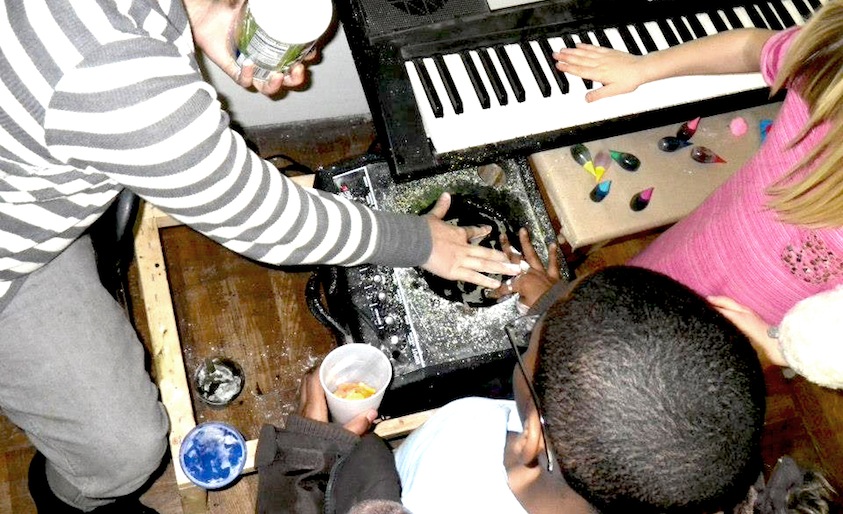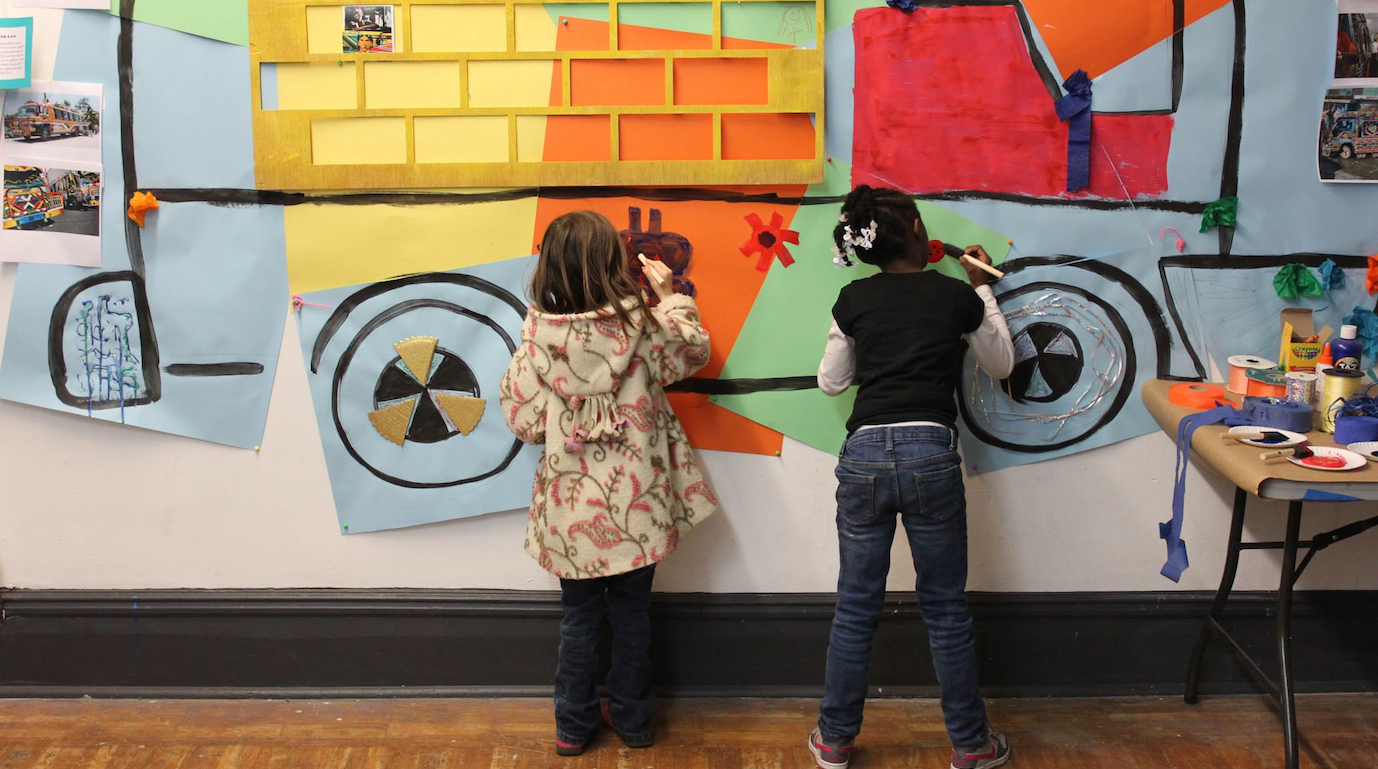Stepping into Assemble is like walking into an explosion of color and creativity. Kids are knitting, creating color wheels, working with tie-dye and electronic light mixers. They are tinkering, painting, soldering and working hand-in-hand with local artists, makers and technologists to build the things they imagine.
The unique makerspace is where art and technology unite.
Located in Garfield, an underserved neighborhood in Pittsburgh, Assemble has become a creative outlet for kids of all ages. On any given day, kids get to learn from, and create things with, makers experienced in robotics, technology, engineering, art, filmmaking and music.
The mastermind behind Assemble is Nina Barbuto, a Pittsburgh native who has a deep-rooted passion for art, new media and social learning. She started Assemble in 2011 because she wanted to help kids gain confidence through exploration and making.
“I wanted kids to see that the things they read about are reachable,” she says.
“When kids make something, they glow with not just enthusiasm, but knowing that they can. Knowing that you can is the biggest part of the battle.”
By having the kids work with experienced makers, she is giving them the chance to see how something is made, why it was made, and how they can make it too. I wanted to “open up the creative processes of people who are doing stuff. It might be with robotics, it might be with art, it might be with installations.”
Assemble, she says, “really helps everyone understand there isn’t much magic behind just doing it.” Instead, making is about tinkering, it’s about messiness, and giving things a try.
Unleashing the Maker Movement
Assemble is part of a larger movement that has, over the last 10 years, moved outside the well-stocked garages of middle class adult men, to communities and classrooms around the world.
In 2005, Dale Dougherty of O’Reilly Media launched the DIY-inspired Make magazine, and in 2006, he started a nationwide series of Maker Faires (public events that celebrate arts, crafts, engineering, science projects and the Do-It-Yourself (DIY) mindset). These were the initiatives that jumpstarted the worldwide Maker Movement.
A few years later, sites like Kickstarter and Etsy gained momentum and gave people a place to share and sell their make-it creations. Maker clubs, hackerspaces, online maker communities and mini-maker faires also popped up around the country. And soon enough, makerspaces started to get noticed by schools. Then in 2012, the Undersecretary of Education Martha Kanter announced that the Defense Advanced Research Projects Agency (DARPA) would open Makerspaces in 1,000 high schools over the span of four years.
Bringing the maker movement into classrooms is important, Sylvia Libow Martinez, co-author of Invent to Learn: Making, Tinkering and Engineering in the Classroom, says, because it’s an “interesting parallel to the kinds of classrooms some teachers want to build—classrooms that are interesting, engaging, full of materials and ideas so that kids can follow their own passions.”
Making time for imagining and creating in schools, she says, also helps bridge the gap between subjects. It unites and revitalizes math, science, history and art; and gives kids a chance to work with their hands.
The maker movement has even caught the attention of the White House. On June 18, 2014, President Obama hosted the first-ever White House Maker Faire and declared June 18 as a National Day of Making. During the event, he called on people across America to join the White House in “sparking creativity and encouraging invention in their communities.”
Assemble Happenings
At Assemble, the creative team understands the importance of encouraging invention and uniting subjects to spark creativity. With each hands-on activity, Barbuto makes sure the kids are using every aspect of STEAM (science, technology, engineering, arts, math).
For example, at a Learning Party, a maker may be showing children how to extract DNA from a strawberry. At the same time, kids may be making a double helix out of gummy bears and Twizzlers, writing poems about their genes, and using sound and motion to do a dance she likes to call ‘The Double Helix Twist.'”
Learning Parties, Barbuto says, “are crazy.”
When kids walk in, they are greeted with bowls of animal crackers, juice boxes, and all kinds of recycled materials. The walls are covered in black newsprint so kids can visually plan their creation. Color carpet squares dot the floor, and Post-it notes are strategically placed around the room to gather ideas and observations. The atmosphere is noisy, colorful and exciting, Barbuto says.
The monthly events are also similar to science fairs, but instead of kids presenting, expert makers are the ones behind the table sharing their hands-on activities with kids. Each Learning Party has a distinct theme such as robotics, gaming or music. The topics, Barbuto says, are vague enough so the kids can be free to explore.
“If it’s an energy learning party,” she says, “imagine someone behind a six foot table with a giant wind turbine and on the other side, kids are pushing it to make energy. They could be making their own windmills or soldering a solar panel.”
At the end of the events, kids get to present their amazing new creations.

Kids work with a maker and experiment with sound, music and color at an Assemble Learning Party. (Photo: Assemble)
Another program Assemble offers to kids is called Saturday Crafternoons—a series of weekly workshops for kids ages 5 to 12 that promotes project-based learning and community engagement.
Each week either a local maker or a like-minded community organization co-facilitates the Saturday Crafternoon.
A community engagement project that Jess Gold really enjoyed facilitating was the creation of a mosaic the kids made for Nelson Mandela Peace Park, located around the corner from Assemble. The kids created a mosaic timeline of Nelson Mandela’s life and placed it in the garden at the park.
Giving kids a sense of community through making is important to the Assemble team because it shows kids that “they have a stake in their neighborhood and the power to make a difference,” says Gold.
One of the other Saturday Crafternoons was devoted to the 2013 Global Cardboard Challenge. With the help of Jennifer Lisa, a local crafter and cartoonist, Gold figured out where they were going to get the recycled boxes and simple materials and how they were going to structure the event.
On the day of the event, five to 12-year-olds makers built an awesome arcade and made mini comics out of recycled cardboard.
“Everyone who participated really loved building arcade games like Caine,” Gold said.
Barbuto hopes that kids not only have fun and learn something at Assemble events like the Global Cardboard Challenge and the Learning Parties, but they also walk away feeling “fearless.”
“I hope that when they leave, they understand that someone made up everything in the world around us, from the food that we eat to the clothes that we wear and the buildings that we live in.”
Kids, no matter where they are from, she says, can “make it up too.”
This story was written by Jenny Inglee, the Imagination Foundation’s Imagination Curator and The Storybook Editor. The first collection of stories in The Storybook focus on the work of inspiring individuals, schools, and organizations that participated in the 2013 Global Cardboard Challenge.
[primary_link_alt text=”Sign me up for The Storybook” href=”https://eepurl.com/MDElb” style=”margin-left: 0;”]


Recent Comments